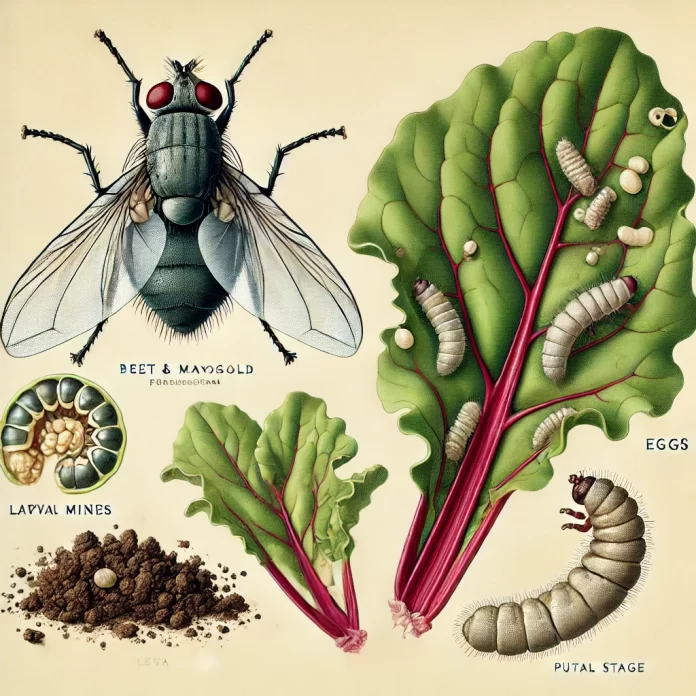Beet and Mangold Fly (Pegomya hyoscyami)
Taxonomy & Classification
- Kingdom: Animalia
- Phylum: Arthropoda
- Class: Insecta
- Order: Diptera
- Family: Anthomyiidae
- Genus: Pegomya
- Species: Pegomya hyoscyami
Description
The beet and mangold fly (Pegomya hyoscyami), sometimes referred to as the beet leaf miner, is a species of fly whose larvae cause significant damage to beets (Beta vulgaris), including sugar beet, red beet, and Swiss chard.
- Adult Fly: A small, greyish-black fly, about 6 mm long, resembling a common housefly but more slender.
- Eggs: Tiny, white, and oval-shaped, laid in clusters on the undersides of leaves.
- Larvae: Creamy-white maggots, reaching about 8 mm in length, burrowing into leaves and forming irregular mines.
Life Cycle
- Egg Stage: Laid in spring on host plant leaves.
- Larval Stage: Maggots hatch within a few days and tunnel between leaf layers, feeding on tissue and creating large brown blotches.
- Pupal Stage: Mature larvae drop to the soil and pupate in small brown cases.
- Adult Stage: New adults emerge in a few weeks, with multiple generations occurring annually in warmer climates.
Host Plants
- Primary Hosts: Beta vulgaris (sugar beet, red beet, mangold, Swiss chard).
- Other Hosts: Occasionally affects spinach (Spinacia oleracea) and other Amaranthaceae species.
Damage & Symptoms
- Leaf Mines: Winding, blistered tunnels between leaf surfaces, often turning brown and drying out.
- Stunted Growth: Reduced photosynthesis weakens the plant, affecting yield in commercial crops.
- Secondary Infections: Damaged leaves are vulnerable to fungal infections and rot.
Control & Management
- Cultural Control:
- Remove and destroy affected leaves to break the life cycle.
- Rotate crops to reduce overwintering populations.
- Biological Control:
- Encouraging natural predators such as parasitic wasps (Diglyphus isaea).
- Using nematodes like Steinernema feltiae in soil to target pupae.
- Physical Control:
- Floating row covers to prevent egg-laying.
- Sticky traps to monitor adult populations.
- Chemical Control (only when necessary):
- Insecticidal sprays targeting larvae, though biological methods are preferred to protect beneficial insects.
Distribution & Habitat
Native to Europe, Pegomya hyoscyami has spread to North America and parts of Asia, thriving in temperate agricultural regions where beets are grown.
Interesting Facts
- The mangold fly name comes from its preference for mangold wurzel, a fodder beet variety.
- The leaf mining habit protects larvae from many insecticides, making early intervention crucial.
Would you like any adjustments or additional details?




